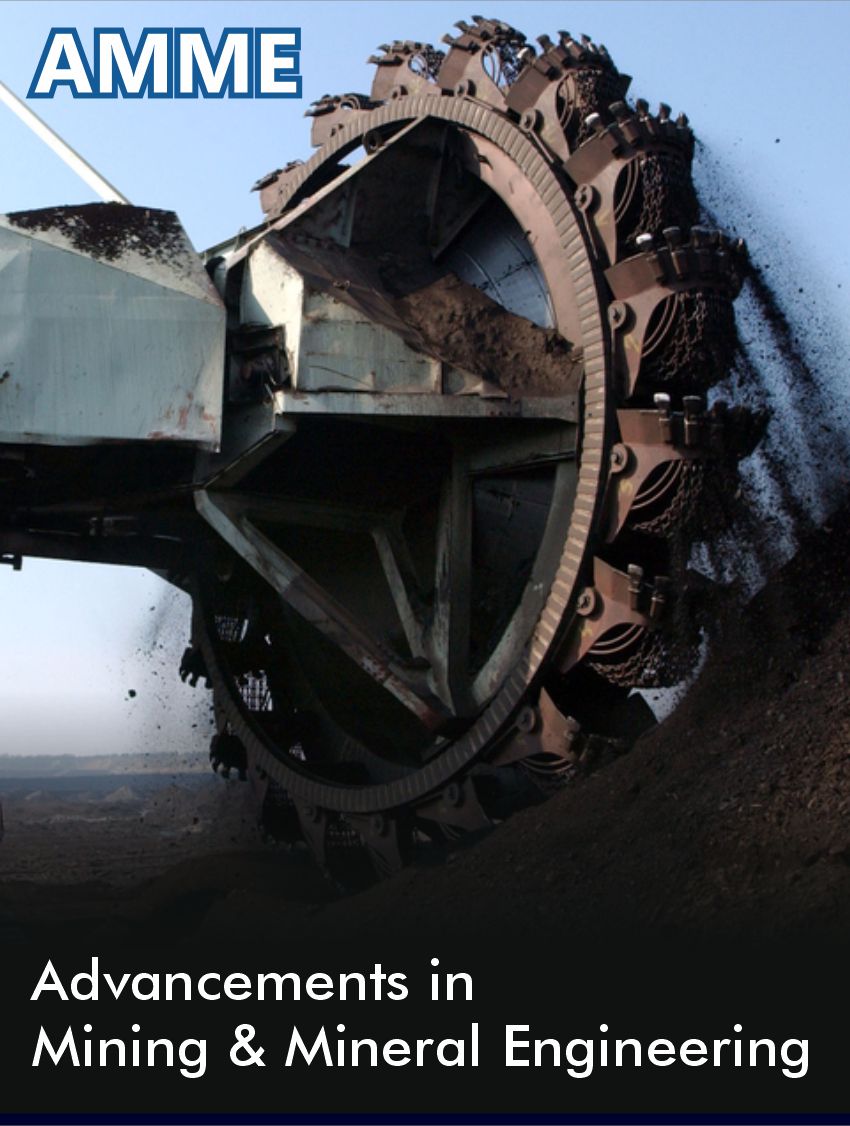 Research Article
Research Article
A Simulation Game in Mineral Exploration: A Mineral Adventure from Exploration to Exploitation
George Valakas1*, Daphne Sideri2, Aikaterini Adam3 and Konstantinos Modis4
1George Valakas Ph. D is a Senior Research Scientist in the School of Mining and Metallurgical Engineering of National Technical University of Athens
2Daphne Sideri Ph. D is a Senior Research Scientist in the School of Mining and Metallurgical Engineering of National Technical University of Athens
3Aikaterini Adam is an Associate Professor of the School of Mining and Metallurgical Engineering of National Technical University of Athens
3Konstantinos Modis is a Professor of the School of Mining and Metallurgical Engineering of National Technical University of Athens
George Valakas, School of Mining and Metallurgical Engineering, National Technical University of Athens, Athens, Greece.
Received Date: June 17, 2023; Published Date: July 17, 2023
Abstract
The simulation as an educational tool is used in the last decades to reinforce scientific knowledge and teach decision-making skills. Surgery and flight simulators are the most known tools to practice and training in safety surgeries and pilots, while the development of simulation games makes progress in other scientific fields such as economics, management, engineering, and mathematics. Simulations enable the learners to apply and develop scientific knowledge and skills in virtual scenarios without risk and enhance the learning process using animation, graphics and an interactive environment. In engineering, although simulation is widely used as a powerful tool of education, simulations with interactive environments and strategies are rarely developed. The difficulty in programming engineering concepts and theories is the main reason for that inconsistency. The present work demonstrates a simulation game in mineral exploration developed by the authors and explains the basic features of the application. The application is based on the generation of random scenarios, while the user applies a strategy according to his knowledge and considering the randomness of physical phenomena. The simulation game is adopted as an educational tool in the course “Introduction to Mineral Exploration” in the school of Mining and Metallurgical Engineering of National Technical University of Athens. Moreover, the outcomes of the game analytics and a qualitative evaluation resulting from three workshops in higher education institutions in Greece is presented.
Keywords: Simulation game; Serious game; Active learning; Interactive simulation; Problem based learning; Mineral exploration; Decision making skills
Introduction
The main objective of modern educational systems is to replace the traditional methods (passive learning) such as lecturing, assigned textbook readings and video watching, with active learning [1], allowing analysis, synthesis, evaluation and reflection [2]. Over the last decades, the academic community and higher education institutions strive to develop educational techniques to enhance the active learning process. There is a wide range of alternatives for promoting active learning as it is reported by the Association for the Study of Higher Education (https://www.ashe. ws/). These methodologies are classified by the level of student involvement [3] and vary from classroom debates to global competitions such as the Global Management Challenge (http:// globalmanagementchallenge.pt/) which is based on business simulations. The upper levels of revisedescribess taxonomy [4] best describe the main tasks of active learning process and indicate the appropriate activities in the classroom depending on the cognitive goals.
In engineering, the most common form of active learning is Problem Based Learning (PBL) [5] and pioneered as learning method by Barrows and Tamblyn at the medical school program at McMaster University in Hamilton in the 1960s [6]. PBL encourages the knowledge acquisition through the experience of solving a problem, allows the students to develop problem-solving skills, increases knowledge and understanding [7], while tutors stimulate them to determine what they need to learn and how to learn it [8]. The crucial motivation of PBL is dealing with real-world problems and therefore PBL has closed connections with simulation.
Simulation Based Learning (SBL) is considered as an extension of PBL method, having common educational objectives and criteria of effectiveness, while featuring some additional advantages [9], such as increased post-training self-efficacy and provision of tangible results. In any case, PBL may be mostly considered as an education strategy, while SBL is mainly a learning technique. The design of PBL and SBL implementation includes the definition of the problem to be solved, the determination of the prior knowledge and skills to be involved and the clarification of the learning outcomes of the process. A simulation is a good PBL approach if it combines the criteria of PBL effectiveness: The ability to engage student’s interest [10-11] and the level of concepts and theories through the experimental learning [12-18].
Nowadays, simulations are intertwined with computer models that have replaced the use of physical objects to substitute the actual objects or systems. Training with computer simulations has been used by aviation, military and medical fields to practice in safety, reduce human-error accidents and save the cost of expensive equipment and materials. These fundamental properties gave impetus to the development of educational simulations in other scientific fields such as economics, management, engineering, and mathematics. Examples of the most known simulations games in education are summarized by [8]. Recent studies [19-20] have shown that simulation games have a significant impact on students’ learning. During the last years, more sophisticated simulation games have been developed to teach multiple concepts in various domains involving user cognition and intuition.
In engineering, although simulation is widely used as a powerful tool of education, simulations with interactive environments and strategies are rarely developed. The difficulty in programming engineering concepts and theories is the main reason for that inconsistency. Furthermore, the demanding framework for game development in combination with the lack of knowledge of academics in general to develop a game, prevents the development of educational applications of this kind. In addition, entertainment companies aim at the development of commercial applications while the potential sales revenue of simulation games is uncertain [21-22] explain the reasons that educational games fail to stand as successful business models. The above difficulties result in the development of simplified simulation games covering simple aspects in a certain domain.
In the next section, we present the crucial features concerning the implementation of simulation games. In the Materials and Methods section, we present the objectives and the description of the developed simulation game, while we explain the implementation background. In the Results, we aggregate the opinions and the suggestions received from the participants in three workshops that were organized to present the simulation game. Furthermore, we report some quantitative results for the game evaluation.
The Simulation Process
In education, simulation is used to represent a natural or invented system that interacts with the user’s actions. The user decisions may concern either modifying parameters to explore the system’s response or affecting the system operations to determine the outcome. Simulations have a close relationship with games since most games incorporate simulations as part of their basic architecture, while both are based on computer models [23], allowing user interaction and providing at least some degree of user control [21]. However, their purpose differs in the learning process. The main objective of simulations is to train the user in several real or hypothetical situations with the required constraints. On the contrary, the game’s purpose is to capture the user’s attention for entertainment and motivation to win since games usually incorporate a competitive scheme. In literature, various terms are used to describe an educational simulation such as interactive computer simulation, interactive simulation, interactive exercise, simulation exercise, computerized simulations, and serious games. Nevertheless, the term “simulation game” combines the objectives of simulation and game in a scientific context with the objective of simulation in priority [22].
The development of a simulation game is a demanding task. Instructors should define the objectives of the simulation game, the degree of user control (interactivity), the surrounding guiding framework, the system’s parameterization, the management of information, the degree of system unpredictability, the simulation game reward system and the learner tracking system. The degree of user control, the surrounding framework, the representation of information and the nature of what is modeled are proposed by [23] and [21-22] as dimensions for classifying simulation games, giving application examples in education. The design of a simulation game including the operations, the actual enjoyment, the player’s effort and the attractiveness are strongly correlated with the satisfaction and motivation of learning [24-25]. Below we describe analytically the basic framework for developing a simulation game.
The objectives of a simulation game
Simulation games in education have the objective to demonstrate the concepts of a course, allowing the interaction with learning materials. Hence, simulation games are used to introduce new concepts, train the user in these concepts and teach the user to manage the adjacent information. A simulation game may cover simple aspects or a range of concepts in a discipline. In particular, the instructor should define the desired learning outcomes of the simulation game such as to increase the student’s knowledge of basic concepts, familiarize with the problem and solving process, develop analytical and critical thinking, improve decision-making skills and manage information.
The surrounding guiding framework
The prior knowledge of the user to run the simulation depends on the nature of the course. Usually, the introduction of simple concepts does not require previous knowledge and a selfdriven application could be used. On the other hand, simulations embedded in a larger sequence of science instructions require prior knowledge. Instructors should identify the essential knowledge coming from other modules or prior courses and decide how to prepare the user to run the simulation game. Moreover, the instructor should decide which evidence will be provided by the simulation game and which knowledge will be acquired by the class lesson. A simulation game may be run in a classroom reducing constraints in the game environment or the simulation may stand alone focusing on self-identifying information and self-assessment.
The degree of user control
The simulation games are classified in applications with a limited, intermediate or high level of user control. The limited user control applications, also known as “targeted” [21-22], allow the control of specific system parameters. These simulations often have the objective of demonstrating simple concepts of the course and the usually stand alone. The intermediate level user control applications, known as “sandbox” simulations [23], allow the user to direct the process and he has a high involvement in determining the outcome of the simulation. Often, sandbox simulations incorporate multiple concepts of a discipline, and the main objective is to improve the decision-making skills of the users and familiarize them with the problem and solving process. Simulations with a high degree of user control allow either the modification of variables to affect the outcome, or the user has access to change the underlying procedure of the simulation.
The system’s parameterization
The system’s parameterization is the core of the simulation game and establishes the capabilities of teaching objectives and the level of interactivity, while it implies the guiding framework and the uncertainty of the underlying system. The instructor should develop the simulation model and determine the operations, the constraints and the processing components. According to [23], the nature of the phenomenon being modeled can be classified into behavior-based, emergent, aggregate and composite models of skills and processes. Behavior-based models allow the user to assign and modify behaviors or systemic constraints. In emergent models, the user interacts with many individual agents leading to an emergent phenomenon. The aggregate simulation models allow the user to interfere with the simulation model. The composite models are used for training users in complex tasks and include receiving a different source of data to simulate activities of a complicated process for science instruction.
The management of information
The management of information includes the way for presenting information, the information flow and the access by the users in the application environment. The representation of information may affect the game’s objectives and researchers suggest that applications with more realistic representations tend to be more powerful for teaching conceptual attributes and they do not disorientate the user from the cognitive process [26]. The information flow or the narrative is a vital element for the development of a simulation game, boosting user engagement. [27] note that user motivation is positively connected to the level of mystery in a narrative type of simulation game. Also, information accessibility is considered for the design of a simulation game. The purposes of the simulation game, the target audience, the nature of information and the user response determine the adaptive features which facilitate the cognitive process.
The degree of system unpredictability
Uncertainty may be introduced in the system operations, on purpose, to affect the behavior of the system. The unpredictability may be referred to the selected scenario or the uncertainty of the simulation model (accuracy of information). For example, dissimilar scenarios can be used with identical structures, or the data may vary due to the model uncertainty. Stochastic simulation games have additional advantages for the instructors and learners. They lead to the production of multiple scenarios with dissimilar results. Repeating the simulation game, learners face a problem which needs a different treatment. Stochastic simulation games allow analysis of different solutions of a problem, familiarize the user with the uncertainty of real world and enhance the conceptual understanding of the handled process.
The simulation game reward system
The reward system in educational simulation game shares the same reward structures with games and may consist of one or more of the following reward forms: the scoring system, the feedback messages, the access system, the user experience level system and the competitive reward system.
The scoring system indicates the performance of the learners according to their actions in a problem and it is useful for selfassessment and comparison. The feedback messages explain score depending on the user response, enhancing the user knowledge. The access system rewards successful learner actions allowing the users to unlock specific features or give more information. The access system serves the ongoing learning principle [28]. The user experience level system is adopted to reward learners for multiple runs of the simulation game, reflecting the time and the effort of the user. It consists of an overall evaluation of user performance in a simulation game based on multiple scenarios. The competitive reward system permits the score compared with other users and motivates the users to come back to the game improving their performance. Tynan S [29] discusses more analytically the motivation reward systems in a game focusing on the psychology aspects of the awards.
The learner tracking system
The learner tracking system constitutes a powerful tool for the instructor with the task to measure, understand and control learner experiences. The analysis of learner experience helps to fix critical issues in user actions, select materials to teach and discover a game weakness. The study of leaner’s actions, behavior and performance helps to improve the simulation game effectiveness and boost retention. The learner tracking system requires a collection server for transmitting data of user-game interaction in case of remote simulation games.
Material and Methods
Simulation game objectives
“A mineral adventure” is the title of demonstrated application. As the title warns, the application deals with mineral exploration disciplines and entices the user into a playful mood. It was developed to support the learning process in the “Mineral Exploration” course which is taught in the fourth semester as an obligatory course of the 5-years master’s program in the school of Mining and Metallurgical Engineering in the National Technical University of Athens (Number of weeks=13, Contact Hours=5, exams). The course introduces the nature and phases of mineral exploration, uncertainty and economic risk assessment, statistical methods for risk estimation, geological models of mineral deposits, geophysical methods, exploratory drilling, ore reserves estimation, feasibility study and exploitation of recoverable reserves.
The simulation game was founded in the framework of the research program “Virtual Mine: as a modeling tool for Wider Society Learning” of European Institute of Innovation and Technology (EIT), Raw Materials Hub – Regional Center Greece in 2018. It is available online at http://geostatistics.eu/exerciseen. php. The aim of the game is to enhance learning by providing an enjoyable learning experience. More specifically, the main objectives are to familiarize the students with basic mineral research concepts, motivate students to develop and test their intuition, and demonstrate to students how frustrating it can be to make decisions under uncertainty. The surrounding framework of the game provides essential evidence which could be used to guide the player to reach a high-performance score without specific prior knowledge. However, a high-performance score could be achieved in a single run, if the player:
• Recognizes what a geophysical survey is and also understands the concept of reliability of the results.
• Is capable of applying Bayes’ Theorem to estimate the a-posteriori probability of orebody existence.
• Can evaluate the provided information to decide on conducting or not a drilling campaign.
• Comprehends the uncertainty in ore reserves estimation.
• Can identify the blocks to be exploited according to the marginal grade of the useful ingredient.
• Estimates the selling price of the ore.
• Understands the relationship between the profit and the mining process/ mineral research.
Simulation game description
The game starts by providing the basic concepts of the posed problem and explaining the user goal. The player acts as a geoscientist manager to direct the mineral research activities from the preliminary research phase to the possible exploitation of the ore body. The user goal is to maximize the profit from selling the mined ore, following the basic principles of mineral research. The user is invited to explore an area of 1,500 x 1,500 m, where there are indications of the presence of an economically interesting ore body. The area is divided into 225 blocks of 100 x 100 m (Figure 1). The a priori probability of orebody existence amounts in this area to 55% and its expected size is of the order of 5 x 5 blocks.
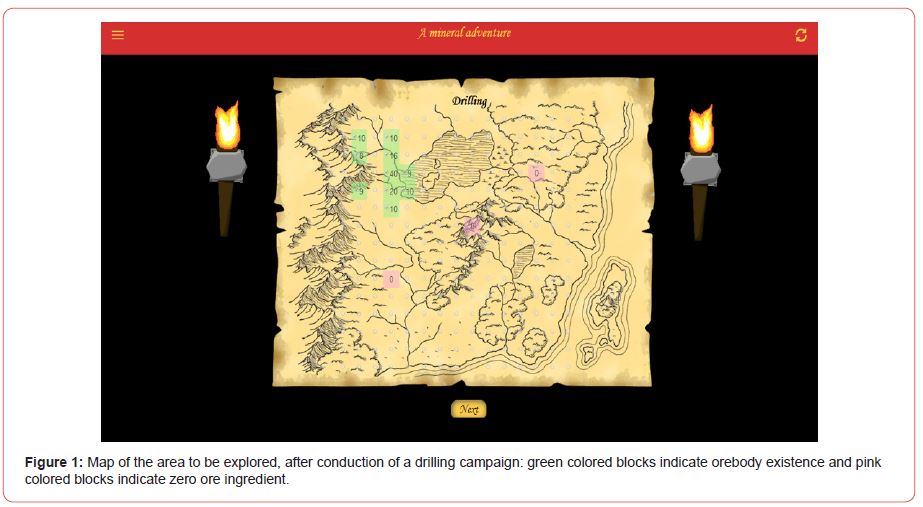
The learner should first decide to proceed or not to a geophysical survey of the subsurface, with a reliability of 80%. The geophysical exploration result may be positive or negative. Subsequently, the learner has to decide whether to proceed to the main exploration phase, or to abandon the survey. If the learner proceeds to the main exploration phase, he needs to apply for funding for exploration drilling. The amount of funding, and ultimately the number of drills he will be able to conduct, depends on the calculation of the probability to discover an ore body according to the geophysical survey result. The demanded probability can be calculated applying the Bayes’ Theorem.
Next, the user is asked whether he would like to conduct a drilling campaign. Drilling is conducted in a predetermined square grid pattern, one borehole at the center of each block. After performing the drilling campaign, the value of the useful ingredient content that is generated is matched to the entire block. The survey ends with an estimate of the ore reserves (Figure 2). The learner can calculate the grade of a block as the average of the samples in the first aureole of blocks surrounding it. The calculation is done automatically by selecting a certain block (Figure 2).
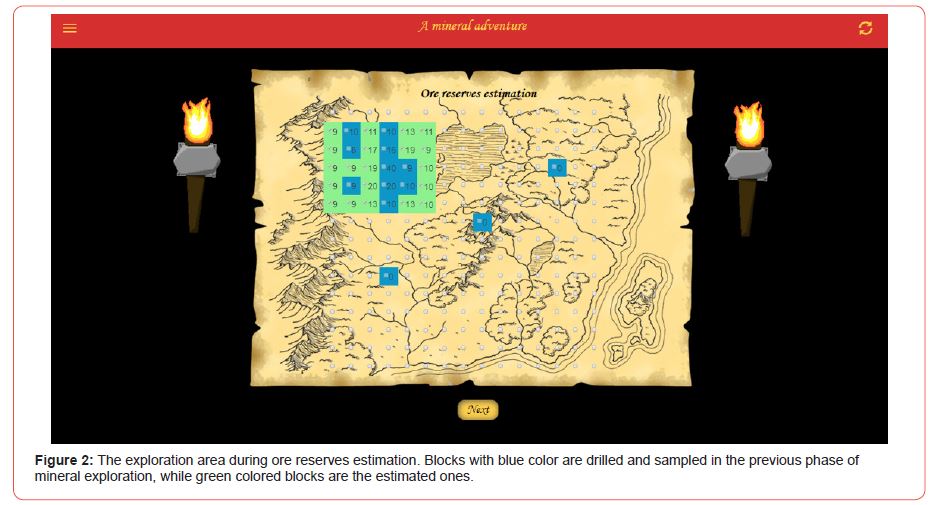
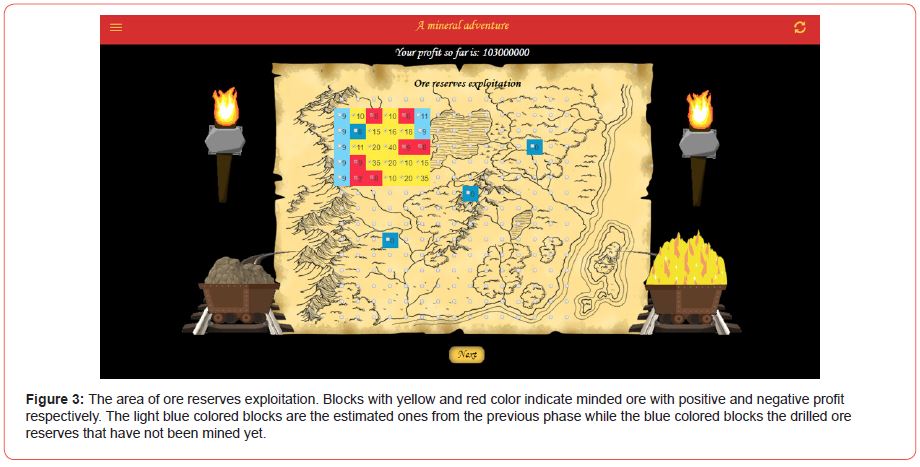

After the survey, and if the learner believes that the results are encouraging, he has the option of proceeding with the exploitation of the field. In this case, the feasibility study concluded that the marginal grade of the useful ingredient is 10%, the selling price of the ore is 200 € / ton, its specific weight is 2 gr / cm3, and the extraction cost for each block is estimated at € 500,000. By selecting a block, he automatically proceeds to extract and then to dispatch it for further processing and sale, if its actual grade exceeds the marginal value, or, if not, to deposit it in the pile of barren (Figure 3). The learner can mine up to all the blocks he has at his disposal, but he also must keep track of his current balance. He can stop mining at any time, so he is informed about his performance score. The final score is determined according to the profit from the sale of the ore he has mined, relative to the best he could have achieved. Consideration is also given to whether he has followed the principles governing mineral research (Figure 4).
Simulation game implementation
The simulation game was developed in JavaScript programming language and rendered on HTML5. Also, PHP language is used to connect to an SQL database for storing user actions and display the results of competitive users. This programming environment facilitates the operation of a simulation game in web browsers requiring only a certain network accessibility. The required unpredictability in modeling the system response is considered by randomly selecting a certain scenario when starting the simulation game. Ten different simulated scenarios have been defined to represent the spatial distribution of the ore body in the research area. Also, the quality of the ore varies in each scenario. All scenarios have the same probability of appearance and repeating the game, a different scenario is placed each time. The geophysics result is also partly random, considering both the existence of an orebody and a random factor representing reliability.
The application provides a graphical user interface inspired by a treasure hunt theme, including papyrus and flaming torches. Also, sound effects are used to engage the user’s attention, such as sound assigned to the buttons, the flaming torches, the geophysical research process, the drilling process, the estimation of ore reserves and the exploitation process. Also, the final score is assigned with proper emotional sound effects. Interactive animations are used to indicate the conduction of geophysical research and the extraction of positive or zero value blocks (Figure1). The user interface is developed to provide a level of mystery, while the rest of the components classify the application to serious games. The application provides step‐by‐step guidance through visual and text clues that are available in a popup sidebar. The popup sidebar includes a calculator to support the calculation of the demanded a-posteriori probability (Figure 5). Also, a graphical explanation is provided for information determining the a-posteriori probability as Figure 6 shows.
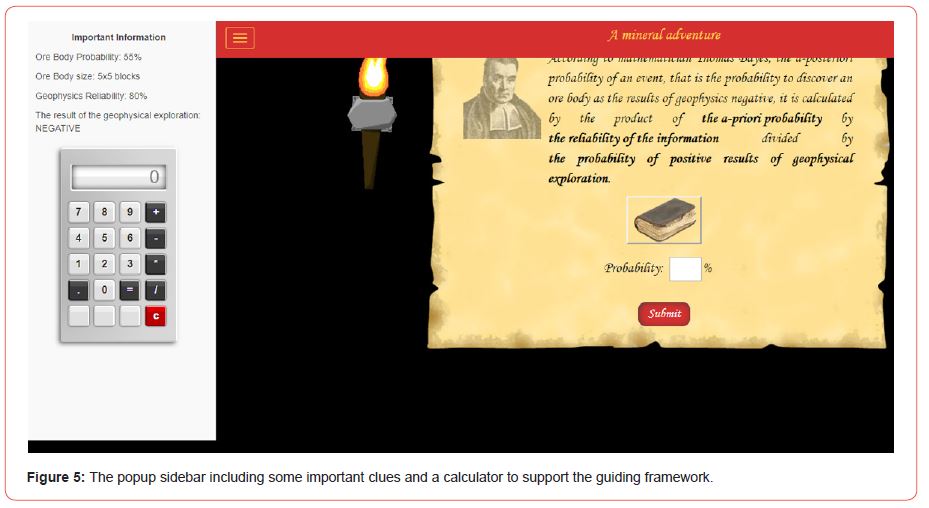
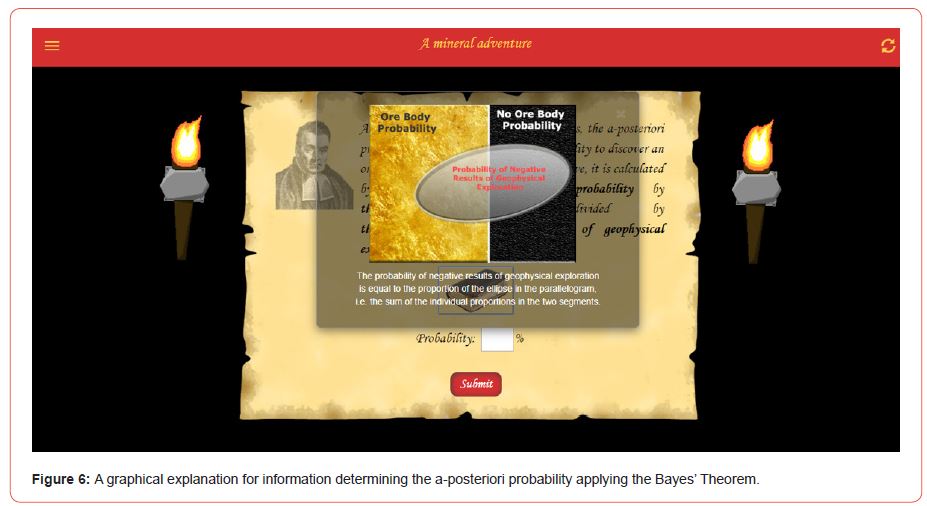
The application rewards the user’s successful determination of the a-posteriori probability of orebody existence by allowing conducting more boreholes, while the incorrect calculation does not affect the final user scoring. The final score is determined according to the profit from the sale of the ore he has mined, relative to the best he could have achieved in the given scenario and the particular outcome of the geophysics campaign, which might be right or wrong. Consideration is also given to whether the user has followed the principles governing mineral research in general. Furthermore, a list with the seven best users scoring with names is loaded and the user could save its scoring performance.
The use of the online database enables to easily collect general information about players such as the time of the day and the date of playing, the user’s location, the user’s device, the length of time spent on the game, the unique visits on the game and the frequency of a user’s returning visits to the game. Furthermore, the system saves the player’s actions, the performance, and the optimal outcome for the running scenario. At the end of the game, the player may save his score with his name on a table which is displayed after the player’s evaluation and it gathers the seven highest scores in the simulation game.
Results
Three workshops were conducted to demonstrate the developed simulation game in National Technical University of Athens (80 participants), Aristotle University of Thessaloniki (45 participants) and University of Western Macedonia (65 participants). The workshops were divided into three sessions. The first session included speeches by guest tutors concerning the risk of mineral exploration. Next, the tutor runs the simulation game demonstrating the game’s features and its operations. In the third session, we discuss the strengths, weaknesses, and opportunities of the simulation game. During the last session, the participants ran the game themselves on their mobile devices. Visits to the game were high, while participants played the game multiple times. In this following analysis, we focus on the participants opinions and the attributes we should improve as they result from the discussion session of workshops.
The participants agreed that the application responds to the educational objectives offering a playful/entertainment mood/ an enjoyable experience. The high participation and the multiple runs of the game confirm the application attractiveness. 72.63 % of the participants played the game, while 88.40 % of them reentered the game and 60.14 % saved their score. Only 11.59 % played the game once, 36.23 % twice and 52.17 % more than three times (Figure 7). The participants also pointed out the importance of visual and sound effects stating their enthusiasm. The players noted the usefulness of the popup sidebar holding the most important information of the game. A motivating challenge to the players was the competitive reward system, as they return to the game to increase their score and to be listed on the table with the seven best players.
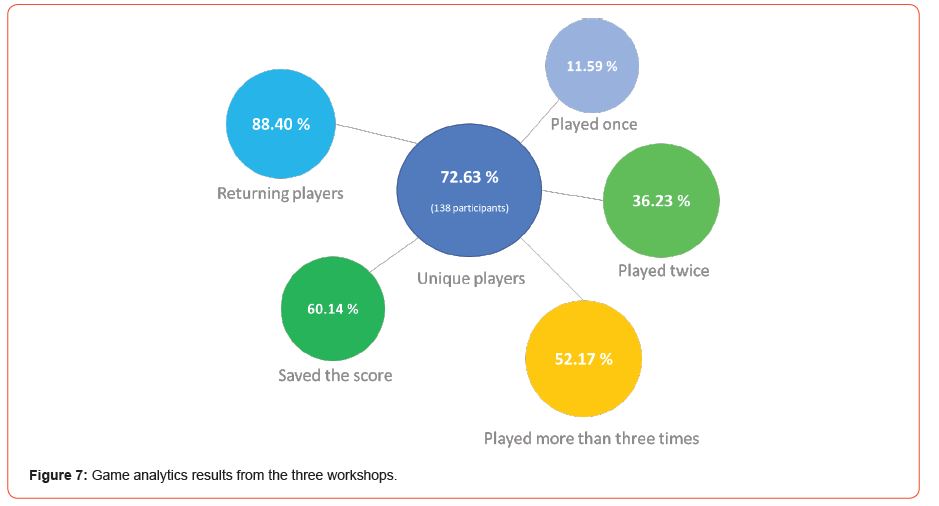
Furthermore, a strong feature of the game is the incorporation of randomness which increases the difficulty of the game motivating the players and familiarizes them with the uncertainty of natural phenomena. Server data indicates that participants continued to play the simulation game a few days after the workshop confirming the importance of remote access on the simulation game.
The main limitations reported by the participants were related to simplifications of area/field representation that is used for ore body exploring. For instance, a 3D representation would be more suitable enabling in representing real-world situations/problems. The participants suggested incorporating a more realistic framework in exploitation phase, by including detailed procedures and increase learner’s involvement. Moreover, participants proposed to add a countdown timer to increase the player’s interest and create psychological pressure. Also, a communication form with the developers would be helpful to consider future suggestions of the learners.
Some more ideas after our experience with the workshops are the incorporation of more scenarios and the possibility that the players will sign up to enter the game. The need to include more scenarios is due to the high rate of returning players. This could be easily achieved by using random values for ore body reserves or changing their location. Also, random values from specific distribution could be used for the selling price of the ore and the reliability of geophysical research. The registration form would add benefits for the tutors and players. The player’s username could assign its university ID number indicating his personal information such as the name and performance in other courses. Thus, the player scores would be linked to an individual profile solving the problem of multiple scores with the same usernames in the table of the best scores. Also, the game analytics would be more wellorganized by intuition facilitating the game evaluation and shaping a better understanding of player experience. Players would review their profile and keep track of their performance, while they could link their score on social networks such as LinkedIn offering a social component.
Conclusion
The presented simulation game serves the objectives of PBL and familiarizes students with basic mineral research concepts. It helps the students to apply their understanding of mineral research and recognize their knowledge deficiencies providing an enjoyable experience. Through the virtual scenarios, the students adopt a scientific approach acting as a geoscientist manager to direct mineral research activities from the preliminary research phase to the possible exploitation of the ore body. Playing the simulation game, students discover/identify the important concepts of mineral exploration and their role in the exploitation process. The students develop their mining strategy without actual economic risk, familiarizing themselves with the cost of situational awareness. Furthermore, the players face how frustrating it can be to make decisions under uncertainty. This simulation game could be adopted in the learning process by other higher institutions for dissemination of scientific knowledge in mineral exploration.
In this phase of the simulation game implementation, we focus on a qualitative evaluation of the game, resulting from the three workshops in higher education institutions in Greece. The participants pointed out the strengths, weaknesses, and opportunities which will be considered in a future version of the simulation game. Further research should be conducted to evaluate its effectiveness. The evaluation will be more expressive when relevant courses adopt the application as an educational technique to enhance the learning process. Higher education institutions and distance learning programs could use our simulation game since it is free and requires only network accessibility.
Acknowledgement
The developed simulation game has received funding from the European Institute of Innovation and Technology (EIT), Raw Materials Hub in the framework of “Virtual Mine: as a modeling tool for Wider Society Learning” research program.
Conflict of Interest
No conflict of interest.
References
- Tabrizi S, G Rideout (2017) Active learning: Using Bloom's Taxonomy to support critical pedagogy. International Journal for Cross-Disciplinary Subjects in Education (IJCDSE) 8(3): 3202-3209.
- Bloom BS, MD Engelhart, EJ Furst, WH Hill, DR Krathwohl (1956) Taxonomy of educational objectives: The classification of educational goals. Handbook I: Cognitive domain. New York: David McKay Company.
- Bonwell C, E James (1991) Active Learning: Creating Excitement in the Classroom. Information Analyses - ERIC Clearinghouse Products (071), Pp3.
- Anderson L, DA Krathwohl (2001) Taxonomy for learning, teaching and assessing: A revision of Bloom's Taxonomy of Educational Objectives. New York: Longman.
- Anastasios Stamou, Constantinos Noutsopoulos, Anna Kuhlmann, Peter Rutschmann (2019) How can we link teaching with research in our engineering courses? The case of an ecological modelling course in two European Universities. European Journal of Engineering Education 45(4).
- Barrows HS, RM Tamblyn (1980) Problem-based learning: an approach to medical education. Springer Publishing, New York NY.
- Diana F Wood (2003) ABC of learning and teaching in medicine: Problem based learning. BMJ 326(7384): 328-330.
- Uden L, C Beaumont (2005) Publishing Technology and Problem-Based Learning, Information Science ISBN 1591407443.
- Deshpande A, S Huang (2011) Simulation Games in Engineering Education: A State-of-the-Art Review. Computer Applications in Engineering Education 19: 399 - 410.
- Wolfe J (1985) The Teaching Effectiveness of Games in Collegiate Business Courses, Simulation & Games 16: 251-288.
- Duch BS Gron, D Allen (2001) The Power of Problem-Based Learning, A Practical ‘How To’ For Teaching Undergraduate Courses in Any Discipline, Stylus Publishing, LLC.
- Miller HE, PL Schumann, PH Anderson, TW Scott (1998) Maximizing Learning Gains in Simulations: Lessons from the Training Literature. Developments in Business Simulation and Experiential Exercises 25: 217-223.
- Anderson PH, L Lawton (1997) Demonstrating the Learning Effectiveness of Simulations Where We Are and Where We Need to Go. Developments in Business Simulations and Experiential Exercises 24: 68-73.
- Green D, AJ Faria (1995) Are Good Strategies Consistently Good? Developments in Business Simulations and Experiential Exercises 22: 31-37.
- Hemmasi M, LA Graf (1992) Managerial Skills Acquisition: A Case for Using Business Policy Simulations, Simulation & Gaming 24(4): 298-410.
- Wolfe J (1990) The Evaluation of Computer-based Business Games: Methodology, Findings, and Future Needs. In Gentry JW, Guide to Business Gaming and Experiential Learning, New York: Nichols/GP Publishing 279-300.
- Schellenberger, RE, JA Hill, RB Keusch (1989) An Exploratory Study of the Effect of Strategic Emphasis in Management Games on Attitudes, Interest, and Learning in the Business Policy Course. Developments in Business Simulations and Experiential Exercises 16: 178-181.
- Teach R G Govahi (1988) The Role of Experiential Learning and Simulation in Teaching Management Skills, Developments in Business Simulation & Experiential Exercises 15: 65-71.
- Hamzeh F, C Theokaris, C Rouhana, Y Abbas (2017) Application of hands-on simulation games to improve classroom experience, European Journal of Engineering Education 42(5): 471-481.
- Nese Sevim Cirak, Zahide Yıldırım (2019) Educational use and motivational elements of simulation games for mining engineering students: a phenomenological study, European Journal of Engineering Education 45(4).
- Gershenfeld A (2009) Bringing game-based learning to scale: The business challenges of serious games. Paper commissioned for the National Research Council Workshop on Gaming and Simulations, October 6-7, Washington, DC.
- Mayo MJ (2009) Bringing game-based learning to scale: The business challenges of serious gaming. Paper presented at the National Research Council Workshop on Gaming and Simulations, October 6-7, Washington, DC.
- Clark D, B Nelson, P Sengupta, C D’Angelo (2009) Rethinking science learning through digital games and simulations: Genres, examples, and evidence. Paper presented at the Learning Science: Computer Games, Simulations, and Education Workshop sponsored by the National Academy of Sciences, Washington, DC.
- Mayer I, H Warmelink and G Bekebrede (2013) Learning in a game-based virtual environment: a comparative evaluation in higher education, European Journal of Engineering Education 38(1): 85-106.
- Hartmann A, L Gommer (2019) To play or not to play: on the motivational effects of games in engineering education, European Journal of Engineering Education.
- Jan L Plass, Bruce D Homer, Elizabeth O Hayward (2009) Design factors for educationally effective animations and simulations. Journal of Computing in Higher Education 21: 31-61.
- Wilson KA, Bedwell WL, Lazzara EH, Salas E, Burke CS, Estock JL, Orvis KL, and Conkey C (2009) Relationships between game attributes and learning outcomes: Review and research proposals. Simulation & Gaming 40: 217-266.
- Gee JP (2007) What video games have to teach us about learning and literacy. New York: Palgrave Macmillan.
- Tynan S (2013) Designing Games: A Guide to Engineering Experiences. Sebastopol, CA: O'Reilly Media.
-
George Valakas*, Daphne Sideri, Aikaterini Adam and Konstantinos Modis. A Simulation Game in Mineral Exploration: A Mineral Adventure from Exploration to Exploitation. Adv in Mining & Mineral Eng. 1(2): 2023. AMME.MS.ID.000507.
-
Simulation game, Serious game, Active learning, Interactive simulation, Problem based learning, Mineral exploration, Decision making skills
-

This work is licensed under a Creative Commons Attribution-NonCommercial 4.0 International License.



